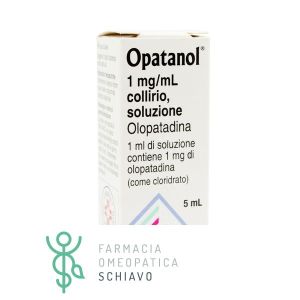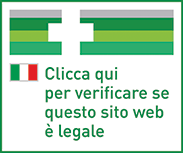Ship in Europe, Find out rates!
Opatanol 1mg/ ml Olopatadina Collirio 5 ml

- box Delivery in Italy in 24/48 and free returns
- star3.000+ positive reviews
- dropboxOver 60,000 products in the catalog
Eye drops based on olopatadine.
Therapeutic indications
Opatanol Collirio is used to treat the ocular signs and symptoms of seasonal allergic conjunctivitis.
Dosage and Posology
The drug should be taken according to the following doses and methods: one drop of Opatanol in the conjunctival sac of the affected eye (s) twice a day (every 8 hours). Treatment can be extended up to four months if considered necessary.
No dose adjustment is required in elderly patients. The drug can be used in pediatric patients (3 years and older) at the same dose as for adults. The safety and efficacy of Opatanol in children under the age of 3 have not yet been established. No data are available. Olopatadine, in the form of eye drops (Opatanol), has not been studied in patients with liver or kidney disease. However, in case of hepatic or renal insufficiency, it is not considered necessary to modify the dosage.
For ophthalmic use only. After the cap has been removed, if the safety ring has come loose, remove it before using the product. In order to prevent contamination of the dropper tip and solution, take special care not to touch the eyelids, surrounding areas or other surfaces with the dropper tip of the bottle. Keep the bottle tightly closed when not in use. In case of concomitant therapy with other topical ocular medicinal products, a five-minute interval should be left between one administration and the next. Eye ointments should be given last.
Overdose
There are no data on overdose in humans following accidental or deliberate ingestion. Olopatadine is characterized by a low order of acute toxicity in animals. Accidental ingestion of the entire contents of one bottle of Opatanol would result in a maximum systemic exposure of 5 mg of olopatadine. This exposure would be equivalent to a final dose of 0.5 mg / kg in a 10 kg child assuming 100% absorption.
QTc interval prolongation was observed in dogs only at exposures considered sufficiently in excess of the maximum human exposure indicating minimal relevance for clinical purposes. An oral dose of 5 mg was administered twice daily, for 2.5 days, to 102 young and elderly healthy male and female volunteers, with no significant prolongation of the QTc interval compared to placebo. The steady-state range of peak olopatadine plasma concentrations (35 to 127 ng / mL) observed in this study represents a safety margin of at least 70-fold for topical olopatadine with respect to effects on cardiac repolarization. In the event of an overdose, appropriate monitoring and treatment of the patient should be undertaken
Contraindications
Hypersensitivity to the active substance or to any of the excipients.
Side effects
In clinical studies involving 1,680 patients, Opatanol was administered one to four times daily in both eyes for up to four months, as monotherapy or add-on therapy to 10 mg loratadine. Adverse reactions associated with the use of Opatanol may occur in approximately 4.5% of patients; however, only 1.6% of patients discontinued the clinical study due to these adverse reactions. Clinical studies did not report any serious ophthalmic or systemic adverse reactions related to Opatanol. The most frequent treatment-related adverse reaction is eye pain, reported with an overall incidence of 0.7%. Tabulated list of adverse reactions The following adverse reactions have been reported in clinical trials and post-marketing data and are classified according to the following convention: very common (≥1 / 10), common (≥1 / 100 to <1 / 10), uncommon (≥1 / 1,000 to ≤1 / 100), rare (≥1 / 10,000 to ≤1 / 1000), very rare (≤1 / 10,000) or not known (frequency cannot be defined based on available data). Within each frequency class, adverse reactions are listed in order of decreasing severity
- Infections and infestations
- Uncommon: rhinitis
- Disorders of the immune system
- Not known: Hypersensitivity, swelling of the face
- Nervous system disorders
- Common: headache, dysgeusia
- Uncommon: dizziness, hypoesthesia
- Not known: somnolence
- Eye disorders
- Common: eye pain, eye irritation, dry eye, abnormal eye sensation
- Uncommon: Corneal erosion, corneal epithelial defect, corneal epithelial disorder, punctate keratitis, keratitis, corneal staining, ocular discharge, photophobia, vision blurred, visual acuity decreased, blepharospasm, ocular discomfort, ocular pruritus, conjunctival follicles, disorder conjunctival, foreign body sensation in eye, lacrimation increased, eyelid erythema, eyelid edema, eyelid disorder ocular hyperaemia
- Not known: Corneal edema, eye edema, eye swelling, conjunctivitis, mydriasis, visual disturbance, eyelid margin crusting
- Respiratory, thoracic and mediastinal disorders
- Common: nasal dryness
- Not known: dyspnoea, sinusitis
- Gastrointestinal disorders
- Not known: nausea, vomiting
- Skin and subcutaneous tissue disorders
- Uncommon: contact dermatitis, skin burning sensation, dry skin
- Not known: dermatitis, erythema
- General disorders and administration site conditions
Common: fatigue
Not known: asthenia, malaise
In some patients with significantly damaged cornea, cases of corneal calcification have been reported very rarely in association with the use of phosphate-containing eye drops.
Pregnancy and breastfeeding
There are no or limited data from the use of olopatadine by the ophthalmic route in pregnant women. Animal studies have shown reproductive toxicity following systemic administration. Olopatadine is not recommended during pregnancy and in women of childbearing potential who are not using contraceptive measures.
Available data in animals have shown excretion of olopatadine in milk following oral administration (for details see section 5.3). A risk to the newborns / infants cannot be excluded. Opatanol should not be used during breastfeeding.
Special warnings
Opatanol is an antiallergic / antihistamine which, although administered topically, is absorbed systemically. In case of severe reactions or hypersensitivity, discontinue treatment. Opatanol contains benzalkonium chloride, which can cause eye irritation. Benzalkonium chloride has been reported to cause punctate keratopathy and / or toxic ulcerative keratopathy. Patients with dry eyes or other conditions in which the cornea is compromised should be carefully monitored for frequent or prolonged use.
Benzalkonium is known for the discoloring action of soft contact lenses. Avoid contact with soft contact lenses. Patients should be advised to remove contact lenses prior to administering eye drops and to wait at least 15 minutes after instillation before reinserting contact lenses.
Expiry and retention
Check the expiration date indicated on the package. The expiry date indicated on the package refers to the product in intact packaging, correctly stored. Discard the product four weeks after first opening. This medicinal product does not require any special storage conditions.
Warning : do not use the medicine after the expiry date indicated on the package.
Composition
1 ml of Opatanol contains:
Active principle
1 mg of olopatadine (as hydrochloride)
Excipients
Benzalkonium chloride, sodium chloride, disodium phosphate dodecahydrate (E339), hydrochloric acid (E507) (for pH adjustment), sodium hydroxide (E524) (for pH adjustment), purified water


